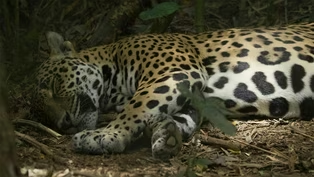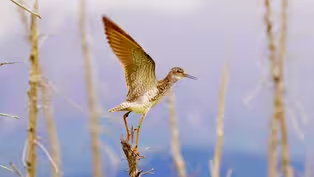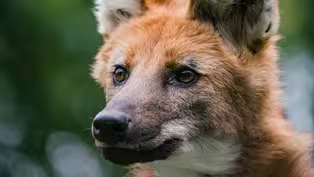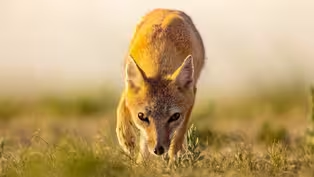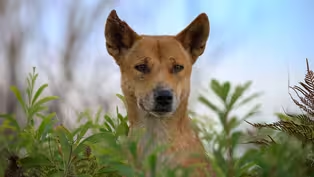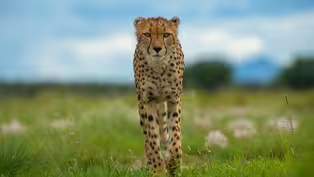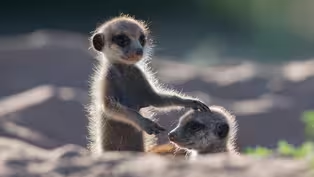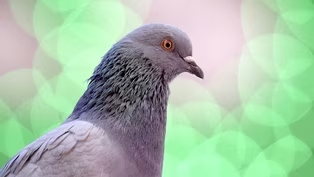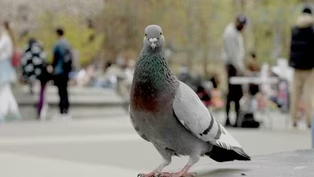
The Pigeon Hustle
Season 44 Episode 3 | 53m 33sVideo has Audio Description, Closed Captions
Uncover the secret world of New York and London’s resilient pigeon flocks.
Uncover the secret world of New York and London’s resilient pigeon flocks, seeing how they adapt to the challenges of city life and thrive alongside people. Narrated by Bobby Moynihan.
See all videos with Audio DescriptionADProblems playing video? | Closed Captioning Feedback
Problems playing video? | Closed Captioning Feedback
Major support for NATURE is provided by The Arnhold Family in memory of Henry and Clarisse Arnhold, Sue and Edgar Wachenheim III, The Fairweather Foundation, Charles Rosenblum, Kathy Chiao and...

The Pigeon Hustle
Season 44 Episode 3 | 53m 33sVideo has Audio Description, Closed Captions
Uncover the secret world of New York and London’s resilient pigeon flocks, seeing how they adapt to the challenges of city life and thrive alongside people. Narrated by Bobby Moynihan.
See all videos with Audio DescriptionADProblems playing video? | Closed Captioning Feedback
How to Watch Nature
Nature is available to stream on pbs.org and the free PBS App, available on iPhone, Apple TV, Android TV, Android smartphones, Amazon Fire TV, Amazon Fire Tablet, Roku, Samsung Smart TV, and Vizio.
Buy Now
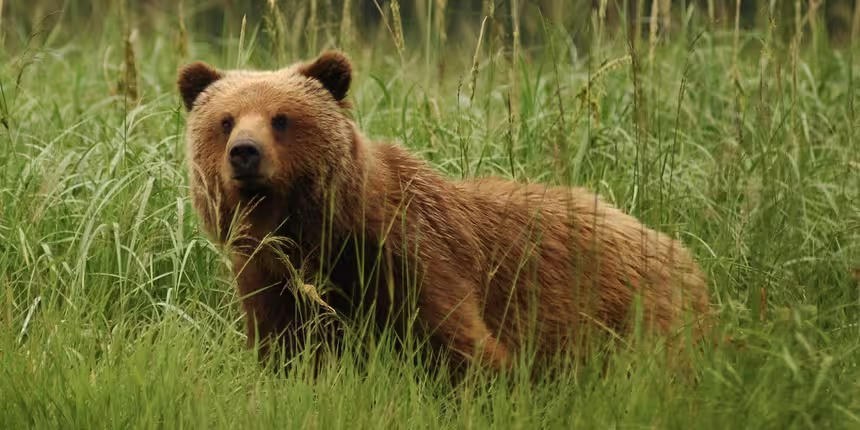
Explore More Ways to Watch
Bring the beauty and wonders of wildlife and natural history into your home with classic NATURE episodes.Providing Support for PBS.org
Learn Moreabout PBS online sponsorshipMore from This Collection
Here are the episodes of NATURE currently available to stream online. We’ll keep this list updated as frequently as possible.
Video has Audio Description, Closed Captions
On Costa Rica’s Pacific coast, turtles and jaguars collide in unexpected ways. (53m 38s)
Video has Audio Description, Closed Captions
Follow a woman’s transformative journey as she nurtures wounded hummingbirds. (53m 48s)
Video has Audio Description, Closed Captions
Follow scientists racing against the clock to save the world’s migratory shorebirds. (53m 18s)
Video has Audio Description, Closed Captions
A Caribbean coral reef discovery marks a new chapter in understanding and saving corals. (53m 18s)
Defending Wild Dogs | Dogs in the Wild
Video has Audio Description, Closed Captions
Join scientists as they go to extraordinary lengths to understand wild dogs. (53m 13s)
Secrets of Success | Dogs in the Wild
Video has Audio Description, Closed Captions
How do wild dogs survive and thrive in the wild? (53m 13s)
Meet the Family | Dogs in the Wild
Video has Audio Description, Closed Captions
Meet the many species of canids, the family of wild dogs. (53m 13s)
Video has Audio Description, Closed Captions
Discover the diverse species and personalities of bees who live in a British urban garden. (53m 13s)
Video has Closed Captions
Meet the pioneering group of scientists who transformed our understanding of ecology. (53m 13s)
Animals with Cameras | Episode 3
Video has Closed Captions
Explore the secret lives of animals through their eyes. (52m 59s)
Animals with Cameras | Episode 2
Video has Closed Captions
Explore the secret lives of animals through their eyes. (53m 29s)
Animals with Cameras | Episode 1
Video has Closed Captions
Explore the secret lives of animals through their eyes. (53m 28s)
Providing Support for PBS.org
Learn Moreabout PBS online sponsorship♪♪ -Humanity is not alone in the urban jungles we call home.
One species truly excels at living alongside us.
♪♪ ♪♪ Loved by some and loathed by others, they use an endless range of tricks and dodges to seize opportunities in the heart of the city... ♪♪ ...where the truth about their lives is full of secrets and surprises.
♪♪ It's time to take a walk on the wild side of London and New York... to experience The Pigeon Hustle!
♪♪ [ Pigeon cooing ] ♪♪ ♪♪ ♪♪ [ Pigeons cooing ] ♪♪ With a population more than 300 million strong, you can find pigeons on every continent, except Antarctica.
They're a familiar part of the DNA of our great cities.
But there's nothing ordinary about pigeons.
They're one of the most remarkable birds on earth.
♪♪ This is London -- Europe's biggest city.
♪♪ Every day, thousands of commuters arrive here at Blackfriars Bridge.
♪♪ Few of them realize there's another city beneath their feet... ♪♪ ...a pigeon city!
♪♪ They may be familiar birds, but each is an individual with their own character and story to tell.
Meet Nelson, your typical young street pigeon.
He's been working the city for 2 months now but he's yet to master many skills you need to survive in this metropolis.
[ Train track clacking ] His life started deep inside this bridge.
[ Train rumbling ] Its cast-iron frame is full of dozens of perfect pigeon apartments.
In one of these snug corners, Nelson's parents are preparing for the arrival of their next brood of chicks, known as squabs.
Both of them work to incubate the eggs, keeping them at a constant 98.6 degrees.
The second egg was laid two days after the first, but its chick will develop faster as the second egg contains more protein in the yolk.
They both will hatch just a few hours apart.
Their cozy sanctuary is in sharp contrast to the dangerous world outside.
♪♪ A peregrine falcon!
♪♪ Peregrines use the river to hunt.
Agile enough to snatch a pigeon from beneath the arches of a bridge, they can be on to you in seconds.
And they're not the only threat here.
Lesser black-backed gulls constantly patrol the arches.
♪♪ Young birds are an easy target.
♪♪ [ Gull calling ] Many lives end here on the shoreline beneath the bridge.
But not Nelson's.
Although the predators are dangerous, pigeons have a range of superpowers to help see them through.
♪♪ If Nelson can use these effectively, he just might survive the challenges of London life.
♪♪ We associate pigeons with cities.
♪♪ But it wasn't always that way.
Thousands of years ago, the ancestors of city pigeons lived on sea cliffs and in caves.
There are still a few of their descendants left... ...known as rock doves.
You can find them on the wild coasts of Scotland, living alongside the seabirds.
[ Seabirds squawking ] [ Waves crashing ] ♪♪ People and pigeons first became neighbors around 60 thousand years ago, when we shared the same caves.
Our ancestors domesticated them for food, and we've been together ever since.
♪♪ Venerated by ancient Egyptians... ...used to carry messages in wartime... ...and even studied by Charles Darwin in his work on Natural Selection... ...there's never been a time when pigeons weren't in the picture.
[ Pigeons cooing ] Over the centuries, people have selectively bred them, too, into dozens of variations... ...which has given us the many varieties of city pigeons we see today.
[ Wings fluttering ] ♪♪ One of the most densely populated places in America, the island of Manhattan, is home to 1.6 million people.
♪♪ Its towering buildings are just like man-made sea cliffs.
♪♪ So this is a great place for pigeon to flock.
And pigeons like to be close together.
Flocking helps them look out for predators, stay warm, and spot opportunities.
♪♪ Manhattan is a pigeon paradise.
♪♪ New York pigeons share a really close bond with the human population.
Their ancestors arrived as the pets and companions of generations of immigrants who selectively bred them for racing and shows.
Over the years they escaped.
And now, their descendants are wild in the city.
Each neighborhood of Manhattan offers different opportunities and is home to its own pigeon gang.
The gang you're born into governs where you go, who you hang out with... and above all, the special hustles you'll need to master.
[ Pigeons cooing ] [ Duck quacking ] On the edge of Central Park, one gang has found a sneaky way of making a living.
It's here that the carriage horses are fed.
And the mixture of oats and grains is similar to the diet of a wild rock dove.
[ Pigeons cooing ] The constant cooing of these pigeons is a sure sign they're well fed.
So, there's always a full-throated chorus from this sleek, healthy gang.
[ Cooing continues ] A few blocks downtown on 5th Avenue, it's a very different story.
♪♪ ♪♪ These pigeons have little access to any sort of green space.
They live a completely urban existence... ...surrounded by endless traffic, noise, and pollution.
They're smaller, scruffier, and less well-nourished than the central park flock.
[ Horns honking ] But they've also found a way of making the city work for them.
This gang works to the clock.
The hot dog stand opens every day at 8:00 a.m.
sharp.
And the pigeons gather bang on time for a free handout.
[ Honking continues ] Feeding so close to traffic is dangerous.
And every day the 5th Avenue flock takes huge risks.
[ Horns blaring ] But pigeons have a set of remarkable adaptations to deal with life in all this chaos.
♪♪ With eyes on the sides of their heads they can see an incredible 340 degrees around them.
♪♪ And being a member of a gang helps, too.
♪♪ With so many eyes, the flock covers each other's blind spots.
♪♪ If a car gets too close, a real pigeon superpower kicks in... ...vertical take-off!
♪♪ The birds bend their legs and launch skywards... gaining enough height to prevent the downbeat of their wings from striking the ground.
♪♪ Their breasts are a solid pack of muscle which helps generate enough lift for them to stay airborne.
♪♪ A traffic-dodging pigeon goes from zero to 60 in just two seconds.
A true master of the street and air.
♪♪ ♪♪ In London, young Nelson is looking for his next opportunity.
Although captive birds can live to 30, a city pigeon is lucky to survive for 5 years.
It's a tough life in the urban jungle.
Every day, Nelson has to eat between 10-- and 20% of his body weight just to survive.
And seeking out all that food takes up most of his day.
But already, he's beginning to get an idea of what the streets have to offer... ...learning the best hustles... and discovering where to hang out.
Pigeons have a great memory, and Nelson is creating a mental map of London.
Soon he'll need to hit the streets again.
♪♪ Nearby in Blackfriars Bridge, one of the squabs has just hatched, and the second isn't far behind.
[ Squabs chirping ] Amazingly, pigeons feed their chicks on milk, an ability they share with emperor penguins and flamingos.
High in fat, protein, and antibodies, both adults secrete the milk from a gland in their throat.
They're the only animals in the world where both parents can do this.
The milk is manufactured from just about anything the pigeons eat, so they're able to raise a family on a street diet and breed at any time of the year.
Already the clock is ticking.
In just 32 days, the chicks will be out on their own.
♪♪ Meanwhile, Nelson is heading out.
♪♪ Pigeon gangs aren't democracies.
They have leaders who make the decisions.
♪♪ Nelson just needs to follow... for now.
♪♪ This traffic island is a popular hang-out.
Some people have built a real bond with the birds here.
Pigeons have the ability to learn and memorize human faces -- particularly ones that give them food.
Studies have shown that even if the person changes their clothes, pigeons still recognize them.
Most of the birds here are well-fed locals.
As a rookie, Nelson is forced to keep to the edge of the flock.
To get the best pickings, he'll need to build up his bulk to help force his way up the pecking order to the heart of the action.
In pigeon society, size really does matter.
♪♪ Unlike Manhattan, with its single central park, London is dotted with many greenspaces... ...which offer pigeons a range of refuges across the city.
♪♪ In leafy Margravine Cemetery, some enterprising birds have figured out how to make a living by following a fellow city-slicker... ...the gray squirrel.
Unlike pigeons, sharp-toothed squirrels can crack open nutritious food like nuts.
[ Birds chirping ] So if you follow them around, sooner or later, they might just drop a morsel or two.
[ Pigeons cooing ] But this leafy corner of London is also full of danger.
♪♪ Charing Cross Hospital, which overlooks the cemetery, is home to an active breeding pair of peregrines.
This year, they have 3 month-old chicks already exercising their wings.
[ Chick squawking ] They're constantly hungry.
[ Squawking continues ] The parents need to catch at least three birds a day to keep the family going.
♪♪ So pigeons that choose to forage here are risking their lives.
♪♪ ♪♪ They call it the city that never sleeps.
And pigeons have also embraced the 24-hour lifestyle of the Big Apple.
♪♪ In the heart of midtown Manhattan, Times Square is a world of lights, steel, and concrete.
On the face of it, not much of a haven for wildlife.
Unless, of course, you're an urban specialist.
♪♪ [ Pigeon cooing ] The pigeon gang here has completely embraced this never-ending show of sound and light.
Its well worth adapting your lifestyle to capitalize on this "round-the-clock" food supply.
Scientists have discovered that the constant light has altered the pigeons' body clocks... giving them the ability to feed by day and night.
[ Percussion instruments playing ] With the ceaseless light and noise, getting any sleep at all here is a tall order.
But yet again, for pigeons, it's no problem.
[ Sirens wailing in distance ] Research has revealed that the birds can actually cope for days on end with minimal sleep.
[ Horns honking ] Alongside this, they have the ability to rest half of their brain at a time... ...which allows them to nap with one eye open.
Even in the noisiest, most chaotic place in New York, pigeons need never miss a beat.
[ Percussion instruments continue playing ] [ Honking continues ] ♪♪ ♪♪ ♪♪ In London's Soho Square, it's lunchtime.
♪♪ There's everything available here -- from Asian street food... to fish and chips.
♪♪ These processed carbohydrates and saturated fats are a long way from a pigeon's natural diet.
But unlike other birds, they have the ability to turn our junk food into nutritious milk for their young.
♪♪ ♪♪ Deep inside Blackfriars Bridge... ...the squabs are now two weeks old.
Their first flight feathers have started to appear, but the yellow down remains.
♪♪ [ Squabs squawking ] Both parents are working simultaneously to keep the squabs growing.
[ Squawking continues ] There are just two weeks to go before they face the challenges of the city.
Although most pigeons stick to the routine of following the local flock, it's not uncommon for young birds to strike out alone.
[ Train rumbling ] Nelson has found his way to a London underground station.
It's time for him to go solo.
There's a lot to check out here.
It's well worth patrolling the platform.
[ Man speaking indistinctly over P.A. ]
This station is a terminus, so trains sit stationery for a while.
Perhaps it's worth taking a chance and checking inside for scraps.
♪♪ ♪♪ ♪♪ Un-phased by the train heading off... ♪♪ ...Nelson works the train car.
♪♪ ♪♪ ♪♪ Time to get off.
Finding his way back to the bridge will be no problem... ...as he can use a pigeons most famous superpower... ...navigation.
♪♪ Homing pigeons can find their way home from hundreds of miles away, in less than a day.
They have the ultimate built-in GPS.
How they do it is still not fully understood, but we do know that pigeons navigate with the help of the Earth's magnetic field... ♪♪ ...alongside an ability to find their way using landmarks like buildings and roads.
Recent research has revealed that when they're close to home, they use another sense for fine-tuning their navigation -- smell!
♪♪ The distinctive aromas of their neighborhood literally guide the pigeons in, once they're on their final flight path.
♪♪ [ Train screeching in distance ] [ Train brakes screeching ] ♪♪ ♪♪ In New York City, the temperatures are climbing... ♪♪ ...and so is the appetite for love.
♪♪ It's time for pigeons to strut their stuff.
♪♪ ♪♪ Pumped up and in prime condition, a male pigeon is a sight to behold.
♪♪ With an inflated throat... the feathers on his neck shine with iridescent purple and green -- colors generated by the structure of the feathers rather than pigment.
In "pigeon-vision", the show's even more intense as the birds are able to see ultra-violet light.
[ Pigeon cooing ] Courtship is also accompanied by a special coo.
[ Guttural cooing ] Generated from deep within the pigeon's body... ...their throats work like an amplifier.
[ Guttural cooing continues ] Combined with distinctive bowing and strutting, the cooing cacophony draws in potential mates... while intimidating other males.
But the real sign that male and female are ready to move on... is the pigeon kiss.
This simulates the behavior used to feed baby pigeons... ...a skill these two will be needing soon.
After mating, the male needs to watch his back.
Others want to get in on the act.
So he escorts her as closely as he can, keeping other males clear of his still fertile mate.
♪♪ Pigeons usually mate for life, and a pair will stick together through thick and thin.
♪♪ Only death will end the relationship... ♪♪ ...at which point the surviving partner picks themselves up, dusts themselves off, and starts all over again.
♪♪ Pigeons don't usually mate until they're a year old.
Nelson still has all of this ahead of him.
But other city families are much further along.
On Charing Cross Hospital, the peregrine chicks are close to fledging.
For the local pigeon population, it's time to go on red alert.
♪♪ With three hungry chicks now ready to fly, the falcons must catch a substantial amount of food.
So pigeons need to be very wary.
♪♪ ♪♪ [ Chicks squawking ] Chicks need to learn to kill live prey, so the parents bring back some unfortunate pigeons, alive.
♪♪ But this chick's too slow.
♪♪ In level flight, a pigeon can actually outpace a peregrine.
So this time, the escapee lives to fly another day.
♪♪ Three miles east, Nelson is exploring central London's biggest green space... ...Hyde Park.
♪♪ ♪♪ Generations of Londoners have come here to feed the birds.
♪♪ ♪♪ It may seem peaceful, but there's danger at the water's edge.
♪♪ While most pigeon eyes are trained on tasty treats... ...one pair of eyes is fixed on them.
Hunched down like a leopard, this gull has developed a surprising skill.
♪♪ ♪♪ ♪♪ With his experience of the gulls at the bridge, Nelson knows the value of keeping his distance.
But there are some newly emerged squabs here, and they have no idea of the killer that stalks the edge of the flock.
♪♪ ♪♪ ♪♪ ♪♪ [ Gull calling ] Time for Nelson to move on.
♪♪ There are better opportunities to be had in the city's West end.
♪♪ Operating in this environment will require Nelson to draw on everything he's learned about surviving in the busiest parts of London.
♪♪ Pigeon intelligence may be very different to ours, but their ability to recall thousands of images and situations makes them one of the sharpest birds on the planet.
♪♪ ♪♪ Their brains may not be large, but they're more densely packed with neurons than those of other animals of similar size.
♪♪ Dodging the West End crowds is one thing, but the mission of every city pigeon is to find the way to food, fast.
And being able to decode their environment is a critical skill.
Experiments using rewards placed in pots with colored lids have shown that pigeons quickly learn to associate different colors with food.
♪♪ They're so efficient at doing this, that scientists are using analysis of the machine-like precision of a pigeon's brain to refine artificial intelligence systems.
♪♪ The heart of London's West End is full of patterns, signs, and symbols.
And Nelson knows that some of them mean food.
[ Indistinct chatter ] A pigeon can distinguish combinations of patterns and symbols, too.
That means that they're even able to separate the work of different artists.
In a 1995 study, scientists trained them to distinguish the works of Picasso and Monet based on artistic style... ...something beyond even the cognitive skills of young children.
At three months old, Nelson is still growing up.
He's undergoing his post juvenile molt, and it's really important to keep his feathers in tip top condition.
♪♪ He's learned that fountains offer the best place for a bath.
♪♪ ♪♪ ♪♪ Back inside Blackfriars Bridge, the squabs have completely transformed.
They're now a month old and almost ready to start their lives in the city.
Just a few strands of yellow down will be a clue to their novice status.
The next stage of a city pigeon's journey is the most precarious of all.
♪♪ Squabs get very little help when they leave the nest.
♪♪ Once the chick emerges, it's pretty well out on its own.
♪♪ ♪♪ In New York, near the Brooklyn Bridge, another youngster is facing these challenges for the first time.
He's fledging a little early.
Not all his feathers are fully grown, and he has little insulation, but it's still summer, and that'll give him a fighting chance.
He finally plucks up the courage to join the flock.
This gang, which controls the territory around the subway station, is a hard-bitten bunch.
The squab will need to feed soon if he's to gain enough fat to keep warm and thrive.
Less than half of all squabs make it through their first month.
And failure to compete for food is the main cause of mortality.
♪♪ He's definitely the bottom of the pecking order.
And the other gang members are merciless.
♪♪ ♪♪ [ Squawking ] No parent will come to feed him now.
♪♪ ♪♪ His pigeon instincts are kicking in.
Few squabs survive their first year, but if he can make this milestone, his chances will climb as he joins the breeding population.
He'll need to build resilience, fast, as being a street pigeon has never been tougher.
For a bird that was once revered and celebrated so much, life is now full of extra challenges.
♪♪ ♪♪ London's Trafalgar Square once teamed with pigeons.
[ Pigeons cooing ] In the 1950's and '60s, thousands made their home here.
They were a tourist attraction in their own right, and inspired by Mary Poppins, visitors were even sold pots of pigeon food.
♪♪ But pigeon droppings are acidic and can corrode stone, brick, and metal.
♪♪ By the early years of the 21st century, the attitude towards pigeons began to change.
Our former friends and allies had become pariahs.
The war on pigeons had begun.
♪♪ A complete ban on pigeon feeding was implemented here.
♪♪ And new, feathered allies were enlisted to keep the pigeons away.
♪♪ Harris hawks now patrol the square.
♪♪ They may not have the pace of a peregrine... but a daily tour of the area is enough to deter most pigeons.
The square that once heaved with birds is now almost pigeon free.
♪♪ However, you can't keep a good pigeon down for long.
♪♪ If you work on keeping them out of one place, they'll always find an opportunity somewhere else.
♪♪ They're ingenious and can get into the most surprising places.
♪♪ Back in New York, the Brooklyn gang have worked out that some of the best feeding places are deep underground.
♪♪ Pigeons are so maneuverable that they can navigate the stairs and escalators... ♪♪ ...to exploit the many opportunities beneath the streets!
♪♪ No other bird would do this.
♪♪ ♪♪ Perhaps it's their ability to adapt quickly to our changing world that makes pigeons so successful.
Wherever we go, and however we choose to make a living, pigeons are never far behind... finding new places to live and feed.
[ Chicks squawking ] ♪♪ In London, Nelson is also learning to push the boundaries.
♪♪ River Boats carry passengers up and down the Thames all day long.
♪♪ and if you're brave enough to hop on board, there are plenty of scraps and crumbs to scavenge.
-[ Man over P.A. ]
Good morning, everybody.
[ Speaking continues indistinctly ] Bolder pigeons like Nelson are even happy to take a ride while the tourists admire the sights.
♪♪ This hustle also suits less mobile pigeons.
One of the few wild animals that can live with a disability, these birds still make a living, even with missing toes and feet.
♪♪ Nelson is really making the grade as a city pigeon.
He's learned to make the best of the countless opportunities on the Streets of London.
♪♪ Like millions of others around the world, he's learning the rules of ducking, diving, and surviving here in the city.
♪♪ Pigeons are smart... ...resilient... ...surprising... and inspiring.
♪♪ They live out their lives alongside us, adapting to our changing ways, and working out ingenious hustles to find food and avoid danger.
Our world is theirs, too, and they deserve our respect and admiration.
♪♪ And let's face it, for many people living on this planet, a pigeon is the closest you'll ever get to a wild animal.
♪♪ Long may they thrive... here in the heart of the city.
[ Pigeon cooing ] (music plays through credits) ANNOUNCER: To learn more about what you've seen on this Nature program, visit PBS.org.
♪ ♪ ♪ ♪
How NYC Pigeons Survive the City That Never Sleeps
Video has Closed Captions
Clip: S44 Ep3 | 2m 22s | Times Square never shuts down, and neither do its pigeons. (2m 22s)
Pigeon Dating Rituals: The Strut, The Coo… and The Kiss
Video has Closed Captions
Clip: S44 Ep3 | 3m 26s | Discover how pigeons find a mate for life. (3m 26s)
Pigeon Gangs of New York: 5th Ave vs. Central Park
Video has Closed Captions
Clip: S44 Ep3 | 3m 12s | Who rules the streets -- and skies -- of the city? (3m 12s)
The Pigeon Hustle: The Making Of
Video has Closed Captions
Clip: S44 Ep3 | 9m 43s | Go behind the camera with filmmakers of "The Pigeon Hustle." (9m 43s)
Video has Closed Captions
Preview: S44 Ep3 | 30s | Uncover the secret world of New York and London’s resilient pigeon flocks. (30s)
Providing Support for PBS.org
Learn Moreabout PBS online sponsorship
- Science and Nature

Explore scientific discoveries on television's most acclaimed science documentary series.

- Science and Nature

Learn how centuries of knowledge helped our ancestors understand the mysteries of space.












Support for PBS provided by:
Major support for NATURE is provided by The Arnhold Family in memory of Henry and Clarisse Arnhold, Sue and Edgar Wachenheim III, The Fairweather Foundation, Charles Rosenblum, Kathy Chiao and...
